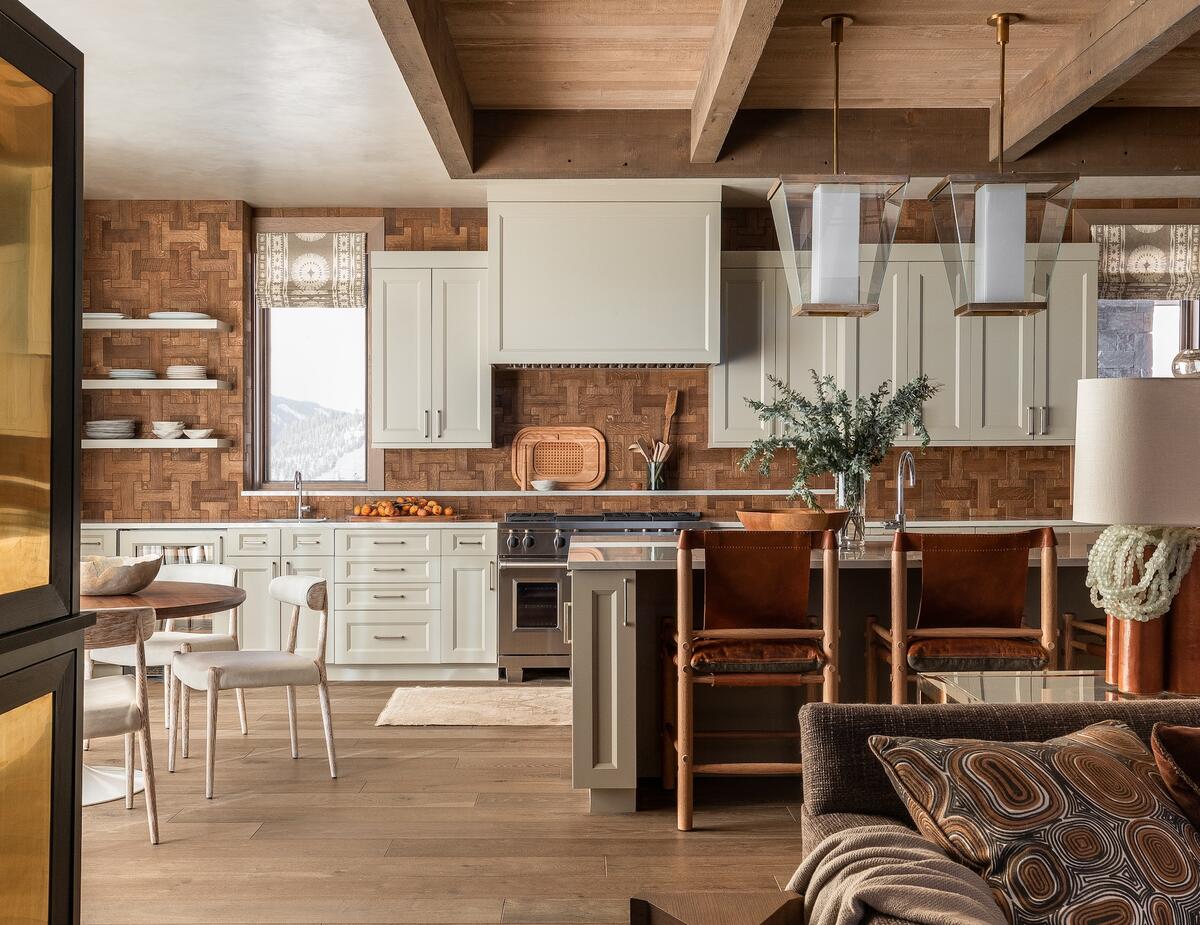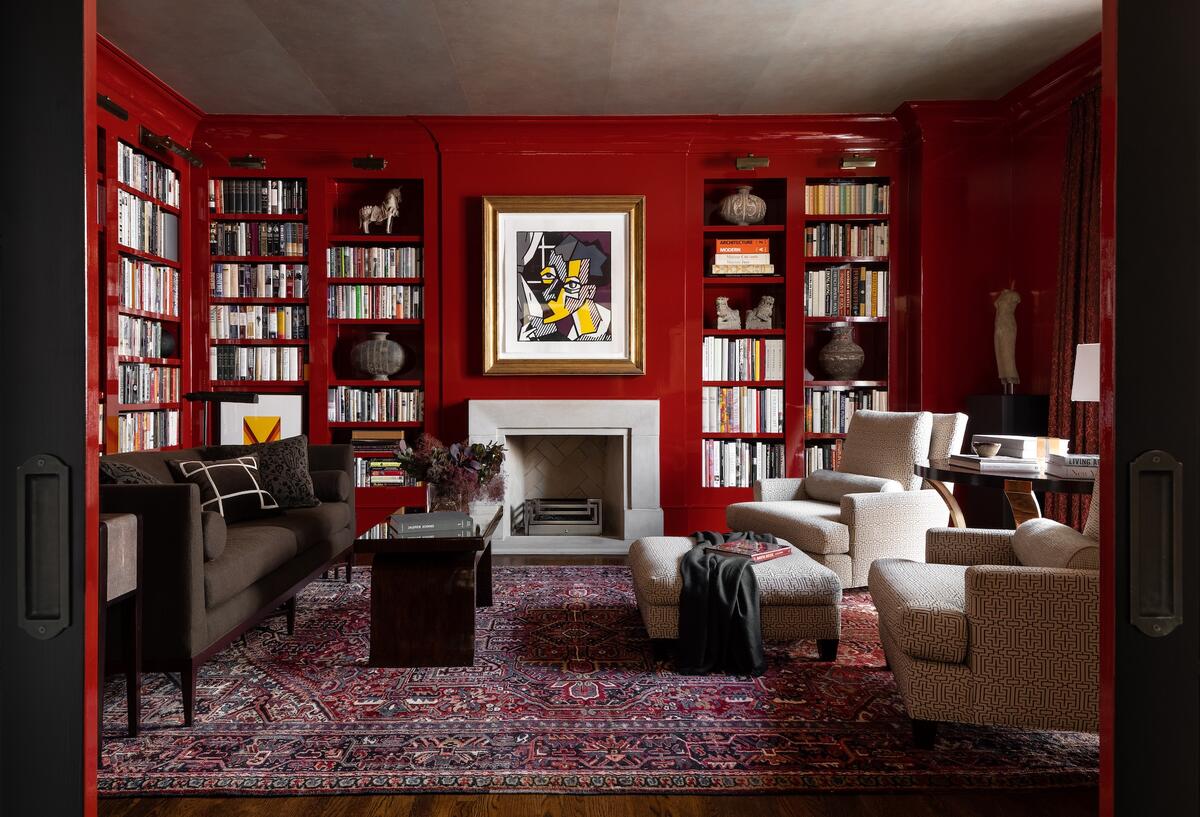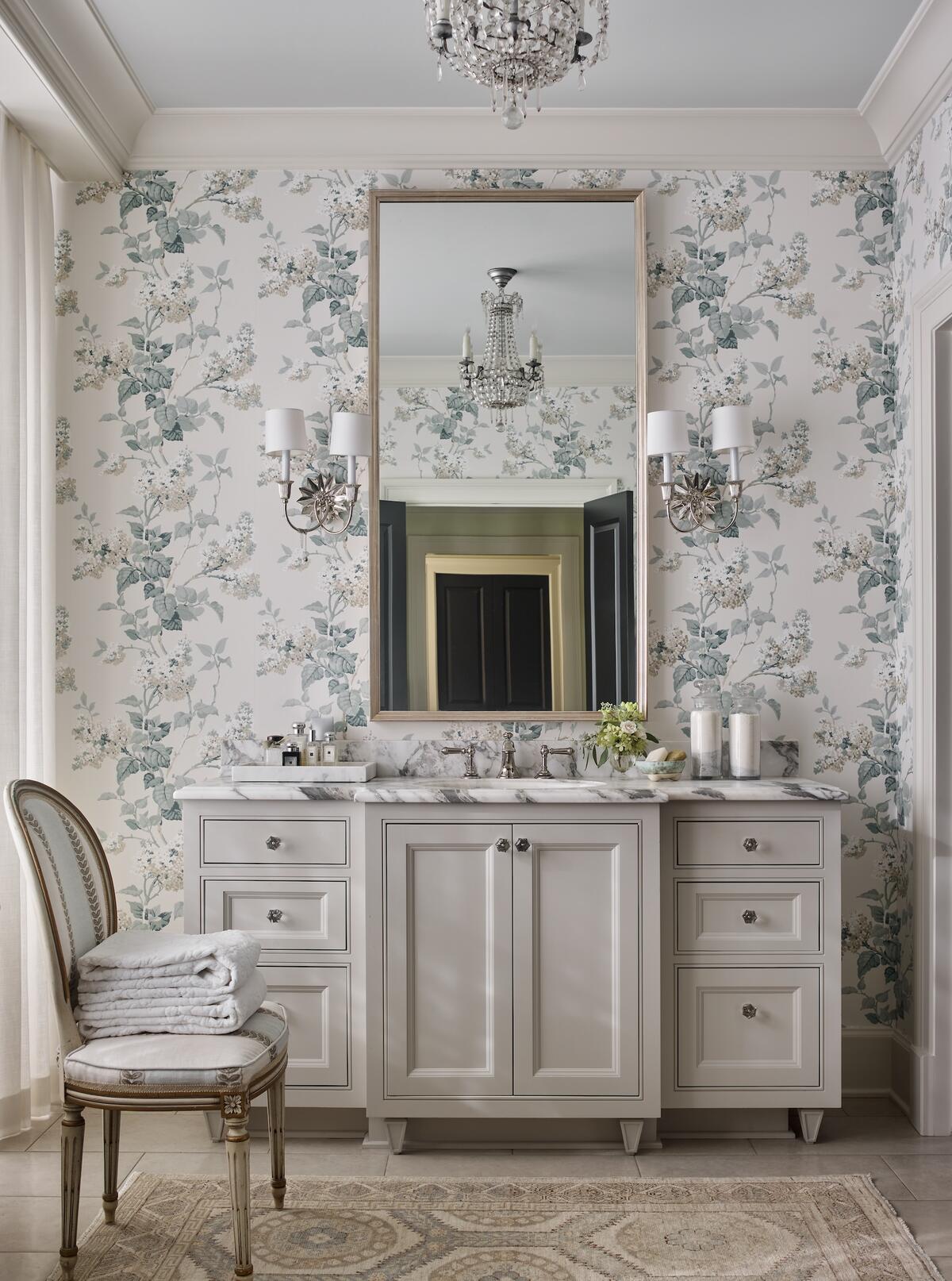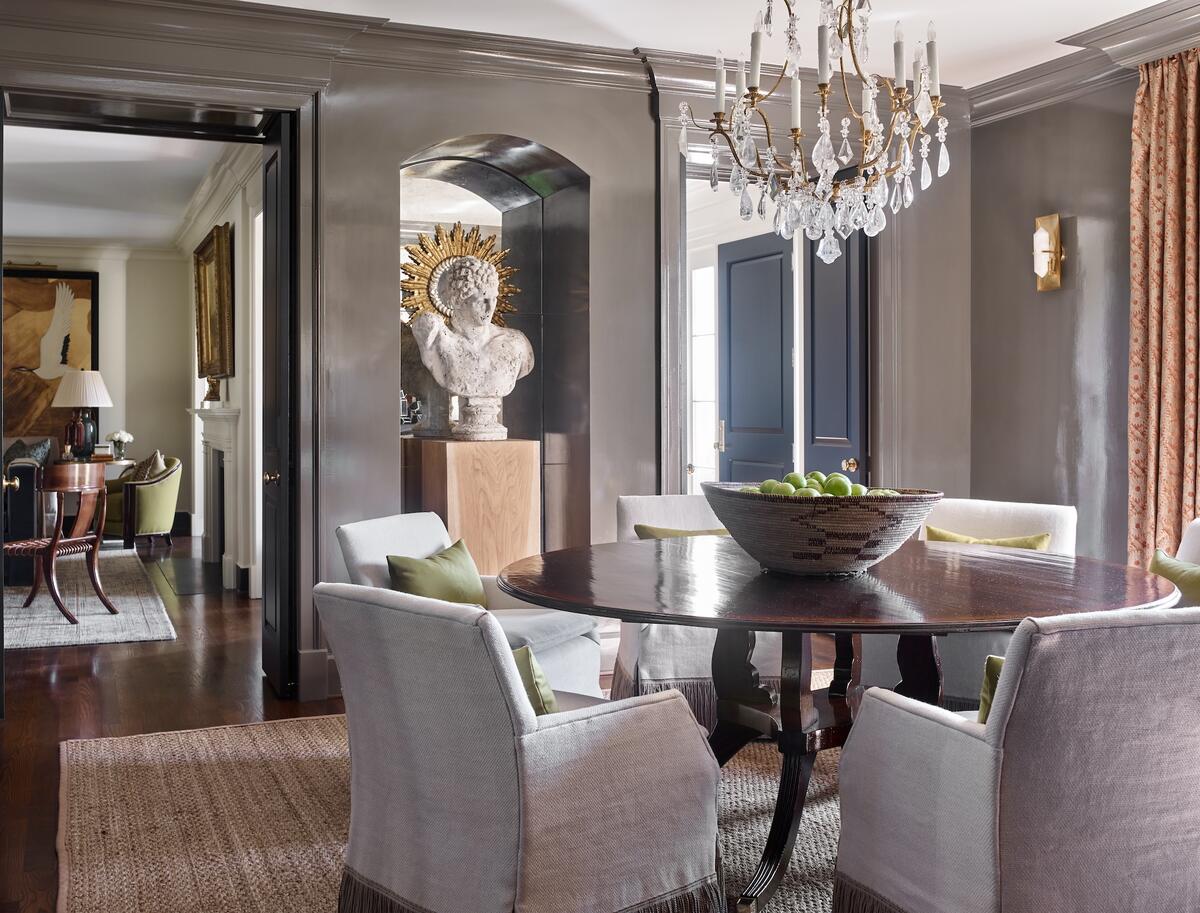The 50 States Project is a series of candid conversations with interior designers across the country about how they’ve built their businesses. This week, Nashville-based designers Roger Higgins and Ann Shipp of R. Higgins Interiors tell us how they divide and conquer the operational and creative aspects of the business, how they retain talent in a competitive market, and why their receiving warehouse has been a crucial ingredient for growth.
How did the two of you meet and start a business together?
Ann Shipp: We met in design school. Roger graduated a semester ahead of me, and the whole time we were in school, he had clients—the school was actually referring Roger for client work! So as soon as we got out, we started working together. Since then, we’ve never actually worked with anybody else. We have done this together for 30 years.
Roger Higgins: We figured it out as we went, which is the most painful and expensive way. But you remember it when you pay for it.
Roger, how did you have clients in design school?
Higgins: I’ve always been one of those people who just did it, and then I thought, “If I want to do this professionally, I need to go to school and get the training.” People would call the school saying, “Can somebody help me with this room?” They weren’t giant projects, and teachers—who knew that I had already done this and that I had some natural ability—would go, “Yeah, send Roger. He’ll be fine.”
Shipp: We have clients right now who worked with Roger when we were in school.
That’s amazing. What did you see in each other that made you confident in your partnership?
Shipp: Roger and I each do something totally different. I wanted to get an interior design degree so I could understand the business; Roger is the creative mind.
Higgins: Ann had an art gallery and was working with designers when she decided to go to design school. I did not have a business—or a head for numbers or anything like that—but I can design anything. We looked at each other and decided, “You’re a good half of this bowling ball.”
Shipp: We’re each half of the bowling ball, and we’re not going anywhere without the other one. I’m the person who makes sure that the schedule happens, that we get the information to the contractor when it needs to be there, or that if we’re given a budget, we’re working within it. I am the person who’s really behind the detail, and Roger is the person behind the design. And it’s worked out really well.
Higgins: I can sketch and sell, and then Ann makes sure it actually shows up.
Where does one stop and the other start in that division of labor?
Shipp: We have a lot of support staff here, too, which is a great thing. But it allows Roger to take a lot more clients. At some point, he steps back [during the execution phase] until we get to a point where we need him again, and he moves to the next job while I’m in the background finishing this one.
Higgins: I never go anywhere without somebody with me, just to keep track of what we’re working on, and then they keep the project moving. And then Ann has the whole business aspect—the billing and all of that—on her plate. It’s a lot.
Shipp: I think it’s especially a lot for someone who is as creative as Roger. His whole brain is taken up with all these beautiful, creative thoughts—he really doesn’t want to know how you made the sausage; he just wants the sausage made. And so that’s what we’re all here for, and that’s what I love and enjoy.
Higgins: Let me tell you, that is a gift for an interior designer.

How did you start hiring, and what does your team look like today?
Shipp: We both went to school at O’More [College of Design] in Franklin, Tennessee, and we have friends in the interior design department [at the college’s current home on the Nashville campus of Belmont University], so we said, “Hey, do you have anybody who’s really great who’s going to be graduating soon?” A lot of our most successful employees come to us when they’re just starting out. They learn our process, and they learn underneath us—that has been a more successful model for us than hiring someone who worked for someone else for years, so we take on a lot of new graduates.
I’m not sure that other people would tell you the same thing, but it works for us—and it keeps us young and wanting to learn new things.
Higgins: Revit is the new thing that everybody uses, and I have no idea how to do any of it.
What does your onboarding process look like to get somebody with no experience set up for success?
Shipp: We have a mentoring process we put them through with employees who have been here for a longer period of time. Anyone who’s new is going to come in and work with one of them to really learn the process before they’re ever put out on their own to do anything.
Higgins: And everybody who comes here has a skill in which they excel. Some people [may be] really great at installations or pushing projects faster, and you just have to guess at which one of the people who work here is going to be a better fit for [me on each part of a project].
Shipp: It’s a lot about personality. That’s something we’ve learned over 30 years: Don’t try to force people to do something they’re not good at. Let’s figure out what you are good at—what you excel at—and let you do that.

What do the teams look like—on the design side and on the execution side?
Shipp: There’s Roger and me, and then we have three senior designers who are assisting in large projects and mentoring the younger staff. We may be doing job site meetings and meeting with the client, but those senior designers sit in with us, and the client starts to know them and understand that they’re a part of it too.
We have a full-time accountant and bookkeeper who work in tandem. We also have an office manager, who takes care of things like health insurance and retirement plans. We have a purchasing agent in Charleston—she’s our only remote employee, and all she does for us all day, every day, is find out what’s going on with our orders. If there’s additional COM information somebody needs, she’s making sure that happens; if we have damages, she’s taking care of those sorts of things.
We also have a full-time person who does running. Her day is: “We need you to go to these eight places to drop this tile off and pick up these parts,” and then she does any receiving that comes into our office. If we get UPS items for clients, she’s figuring out, “Whose is it? Who needs to be notified that it’s here? Where does it need to go?” She works in tandem with our vendors and subs—so if there’s some fabric here that needs to get to the drapery workroom, she’s in charge of getting it there.
Higgins: Just to track the sofa—the frame comes from this place, the fabric comes from that place, the trim comes from this place, and then it ships to this warehouse. I mean, there is a novel’s [worth of information about] that sofa getting here, and that’s just one piece of furniture. It is absolutely overwhelming to get all these parts and pieces together and complete a house—and then you get a giant house, and you have to have people who know what they’re doing and can keep it going.
Shipp: When we hire new people, I always say, “This job is a lot about organization. If you’re not organized, it will really roll over the top of you.” There are so many details that if you miss something, you’re going to get to an install and not have what you need.
Higgins: And both of us try so hard to make sure the clients are just thrilled, so that there’s never a question [of whom to call] when they need to redo a room or build [the next] house. We try to provide a really great level of service, which is a trick some days.
Shipp: We’ve worked really hard and been willing to do a lot of things to make clients happy. If a client calls and wants to have the windows washed? That has nothing to do with interior design at all, but you know what? We have someone we use who’s great, and we’re willing to be a resource for people like that. They know it’s somebody that we vetted and that you can trust to do a great job. And as you build this trust with people over the years, they don’t want to go anywhere else, because they know if they call us, it’s taken care of.
Are you billing for that referral to the window washer? Or is that just a thing you’re willing to do to keep the client happy, and the payout is the promise of their future business?
Shipp: We charge you for our time. And they’re more than happy to pay it because the job is done and it’s done well.
Higgins: And they didn’t have to think about it. But that’s also about having the right client. Not everybody’s going to think that’s the thing to do.

What does your business look like today?
Shipp: Right now, we have about 65 ongoing projects.
Higgins: But here’s the deal: Some of those are new-construction projects that will last for three years or more. Some of them are [smaller jobs] for clients like the lady I went to work for back when I was in school, who recently asked me to do something at her house. They helped when nobody was around, so I go—whenever they call, I make it work.
Shipp: What we have is the support staff who can move in after Roger moves on to the next one.
How does that handoff work?
Shipp: We have a day of the week—Mondays—when Roger stays in the office all day long, and all we do is split that day up into segments so that each designer here is able to sit with Roger for X amount of time and talk about everything that they’re working on, or ask any questions. From that, they have their marching orders to continue moving until we see them again.
How much of your business is returning clients? And how do you decide what you’re saying yes to these days?
Shipp: It’s probably 70-30. Right now, 70 percent of our clients are actually new clients, and the rest are returning. But how do we decide? In the 30 years that we’ve been doing this, that’s one of the hardest things. There are so many wonderful people we’d love to work with, but you have to say no to something. We have gotten to the point where if it can’t be profitable for us, then we have to say no, especially if it’s someone who can’t afford to buy that much from us. The truth is, we don’t make money on our time, so you have to be really careful about people who really just want your time and that’s the end of it. It pays the bills, but we don’t really make money on that. And that’s unfortunate, because sometimes those are great chances to help people, but because this is such a huge machine that we’re running, we have to be much more selective.
Higgins: I’m a sketcher and can draw a concept in front of people, which is a great thing to sell a job. But if I slip up and do it in front of them, they think, “All I need is your sketch.” And that’s really not accurate. They need the sketch, but they also need the three months’ worth of drawings that go with it.
Shipp: It’s difficult sometimes too, because we have these clients we work with for years and years, and they’ll call and say, “I just need some new draperies in this room.” We try so hard to help those people, because, like Roger said, they helped us a long time ago when we were starting out. But it’s a tough question to have to answer, and we have to do it every week.
Higgins: And we tell everybody how we work, and at this point in our careers, if they have a problem with it, then it’s not going to work.
Shipp: It is a big sign to us. We have a contract that we had a lawyer make for us. So when you have people who call and say, “Well, we want to take this piece out or that piece out, or we’re not going to sign this part,” that’s not a good sign, because we are not attorneys, but someone who was hired to protect us said this is what we need to do. If the immediate thing you want us to do is start doing business a different way, it’s probably not going to work.


You were talking about really wanting to have clients who purchase through you. Do you have a furnishings budget threshold that you’re looking at as you assess client fit?
Higgins: We do. But it also depends on the size. If they want to build a 12,000-square-foot house and furnish it for $50,000? That’s probably not a fit.
Shipp: And that’s part of understanding what exactly the job is, because yes, there is a threshold with everything that we agree to take on. We might say, “We are going to have to have a threshold of X dollars in order to be able to take this job,” and they have to agree and we have to agree. That’s part of the contract.
You mentioned billing for time. Has that always been your approach?
Shipp: It’s the only way we’ve ever done it.
Higgins: It’s the only way you can actually be sure of how the project is going. If the client doesn’t want to pay by the hour, and then they want seven different options for everything, you’re not [making any money]. You’re not going to be our client if you’re not going to pay by the hour.
Shipp: Truthfully, it would be a lot easier for us to set a flat fee. You can ask anybody in this office what they like the least, and it would be having to keep up with their time. But what we have found is that it’s the best way to protect our knowledge. We are offering you this service, and so you’re going to pay for our time. When we get to the point where it’s time for you to make purchases, then we give you a quote, you say yes, and the time piece stops until we’re ready to install.
So you’re not billing hourly for all of that procurement work?
Shipp: No. If Roger’s still meeting on the job site with the contractor to answer questions about framing or electrical or those sorts of things, then they are still paying for that time, but as far as placing the order, making sure the order is correct, and getting it here—we’re not charging for that time, because that’s part of the markup that we charged you.
Higgins: We do a lot of work with architects on new-construction projects, and there are just more questions than would be profitable if we [charged] what everybody would want to pay for a flat fee. To talk about some window casing in an upstairs bedroom for an hour and a half, you know, you have to charge them for that, because they may not want to buy all the furniture in the world to support [that level of engagement].

How do you explain your markup to clients?
Shipp: I found that [it’s not an issue] if we’re upfront about it from the very beginning. We’re buying directly from the manufacturer at stocking dealer pricing, so even when I put the markup on it, it’s still less than what it would be sitting for in a store here in town. We’re just really honest about it: “This is how we’re going to mark up labor, and this is how we’re going to mark up merchandise.” I tell everybody that our books are wide open—if they want to see a copy of an invoice, it’s here. When we build transparency with that, there aren’t a lot of questions.
Higgins: And our bills are broken down by 15-minute increments, so if they want to know what we’re doing, they can look at the invoice.
Shipp: What day we did it, what time we spent on it.
Do clients actually ask to see that?
Higgins: No.
Shipp: But it’s part of what we do, so [they know] it’s there. I have said for years, I like to take the surprise out of what we’re doing. I mean, we’re sitting with our clients to understand what they want from us, so when I send them the time bill, they can see that what we spend our time on is completing the things that they have asked us to do. It cuts out a lot of questions. My goal here is we don’t have a single question after the bill. Nobody’s asking a question, because it’s all something that we’ve been over or we’ve explained before it ever got to them.
Do you build that through trial and error over the years? I imagine you tell yourself, “OK, I got this question. How can I prevent that next time?”
Higgins: Yes, absolutely.
Shipp: I tell people in the office that if we can cut out any mistake before it ever makes it to a bill—I feel like, once you’ve made some kind of mistake on a bill, it makes them watch you closely because they’re expecting that again. But if we cut that out, you build to a level of trust where it’s not an issue. It’s the same thing with the warehouse.
That’s right—you’re also running a receiving warehouse. What made you want to get into that business?
Shipp: It’s a completely separate entity. It’s been eight or nine years now. What happened was we had people in town doing this for us and it got increasingly difficult to find somebody who did it well. At one point, I was getting bills for something that happened three months ago—but when we finish a project, it’s really hard to go back three months later and say, “Oh, and by the way, you owe us these warehouse fees.” The way they were doing business just did not make sense with what we needed, or with the level of service we wanted to offer. So we took the money we were spending to do that, and at first we just rented a warehouse and put our stuff there. Then we hired someone, and then we had to hire another person, and the next thing you knew, we had a truck delivering our own stuff too. Roger and I have so many friends in the business, and they started asking, “Hey, maybe you could do it for us too?” And it just sort of mushroomed from there.
When did you realize that it was going to be its own full-fledged business?
Shipp: About five years ago. That’s when we ended up buying a small warehouse. We had about 7,000 square feet of warehouse space, and it was just getting fuller and fuller. I thought, “There’s this huge business here that we can tap into, because there are a lot of people out there who need this service and want to be able to trust someone.” And here’s the thing: You’re never going to move and install this much furniture and not have something break or get scratched. But these people know Roger and me, so they know we’re going to stand behind whatever it is we’re doing and we’re going to make it right.
Higgins: And we know when a lacquered table shows up, it’s got to be handled like it’s made out of feathers, not bungee-corded on top of a truck and hauled out.
Shipp: We had to find the right warehousing software and the right people. We have a full-time person at the warehouse as well, and he can fix it right there if it’s got a small scratch or ding on it instead of having to send it back to the manufacturer. It’s a helpful thing because so many times the designer is trying to get something in and it needs to go out immediately. We don’t have time to put it on a truck and send it all the way back to the manufacturer and then get it back again. We’re now in 28,000 square feet of warehouse space.
Higgins: And it’s full.
Shipp: Yeah, it is absolutely full. I mean, every designer in town is trying to get everything in by Christmas, so they’re calling the warehouse every day saying, “Is my stuff here? Is my stuff here?” Even though we notify them as soon as it comes.
You get to see both sides—the designer’s side and the receiver’s side.
Shipp: I do, yes. When I speak to other designers, I know what it’s like to be in their shoes—to need something here and it’s not, or to have something get to the job site and it’s not what they wanted or something’s wrong with it. Or even trying to work through issues or problems, because maybe the wrong thing got sent—you just never know.
Higgins: It would be good for all designers to be on the other side of that for just a minute.
How has that side of the business evolved?
Shipp: There’s a process when something comes into the warehouse where it’s unboxed, checked for damages, photographed, and then rewrapped and placed in storage. We send the photograph to the designer and say, This is here. It’s damaged or it’s not. They have the photograph to make sure it’s exactly what they ordered. And then we have a software filing system and a barcode scanner that tells us where everything in the building is, and it’s scanned in and out of the building so we know where anything is at any time. Is it on a truck? Is it in the warehouse? Learning about things like that was not really part of the interior design process, and it’s a lot, but it’s also allowed us to buy real estate that will someday be our retirement plan. Also, we have 13 employees in our office at R. Higgins, and then we have 13 employees at the warehouse. So there are 26 people trying to put all these projects together and get them where they need to be when they need to be.


Nashville’s real estate and design scene has been booming. Can you tell me how that’s impacted the types of projects coming your way?
Higgins: Initially, Nashville was the most traditional place on the planet.
Shipp: Southern traditional.
Higgins: But during Covid, when everybody was moving all over the place, we got a lot of new people moving to Nashville.
Shipp: A lot of Californians.
Higgins: It’s caused a huge shortage in the housing market, so people have been building as fast as they can here—and the people who are moving here are bringing their taste and style and ideas with them. It’s changed Nashville all around.
Shipp: Tremendously. Just the volume of people that we have here—and that’s another tie back to the warehouse. We managed to buy real estate very strategically, so our warehouse is sitting in a spot where most of our business is happening. If we were to warehouse everything 40 miles away, it’s a whole lot cheaper, but if we warehouse it right here, we can make 10 more stops a day because we’re right here in town. Especially during Covid, Nashville had this surge of business that was almost impossible to keep up with.
Higgins: We ended up renting another warehouse because ours was so full, and renting storage units too. You cannot imagine the influx of stuff.
Shipp: We’re also noticing that a lot of people moving in from out of town are bringing their out-of-town designers to work with them in Nashville. So those designers are calling around saying, “I need a receiver. Who do you know?” Our warehouse business is doing a lot of business with out-of-town people right now. They want somebody they can trust to make sure what they have is right when they get to town.
What is the biggest challenge that you see in the industry right now?
Shipp: Finding good help—employees who really want to work, and who have a passion for what they’re doing.
Higgins: People our parents’ age started a job and stayed there for a long time. That’s just not the idea anymore, so you have to figure out how to keep the business working properly while employees turn over.
Shipp: We’ve had headhunters calling our employees or contacting them through their business emails, trying to offer them positions at other places. That’s a difficult thing.
It means you’ve built a good team.
Shipp: Well, I hope so. But it’s hard when everybody’s trying to get this small pool of people. I never want anyone to leave!
How do you foster longevity on your team?
Shipp: We have met some really incredible people who come to work for us every day, and just treating them like you would want to be treated if you had that job is so important. It builds loyalty, and it makes them want to stay and work for you because you appreciate what they’re doing.
In the last five years, we’ve learned that our employees are so much more interested in the benefits we’re offering—they’re asking questions like, “What’s your health insurance plan? Are you offering a retirement plan?” Fifteen years ago, nobody expected us to have those kinds of programs. Now, you have to offer those things if you want to get good people. We implemented a retirement program where we match up to a certain point. I think it’d be hard for a smaller interior design firm to do, but it helps us cultivate the right people here, and it makes us more competitive when we’re trying to get the right people.
Higgins: And I’ll tell you, when you’re hiring someone, you want somebody who is looking forward enough to know that that’s important.
Shipp: I don’t know of another receiver that is offering their movers health insurance and a retirement plan. That is a benefit that very few movers are going to get, and that allows us to get people who are committed to doing a good job.

What does success mean to each of you?
Higgins: We’ve got it. I mean, we get to do what we love for people who are incredibly generous and kind. I think we’ve won.
What is the secret to a successful partnership?
Shipp: For us, it’s been: Don’t try to do what the other person is doing. There are clear lines around what Roger does, and there are clear lines around what I do. The only times we end up in a disagreement is when somebody’s trying to step into the other person’s realm. So it’s about being able to say, “Hey, that’s a Roger thing and I’m going to let him make the decision on that,” and him doing the same for me.
To learn more about Roger Higgins and Ann Shipp, visit the R. Higgins website or Instagram.





























